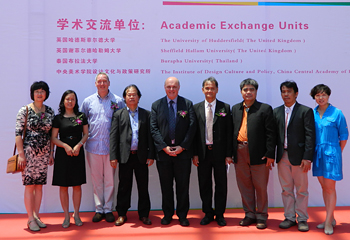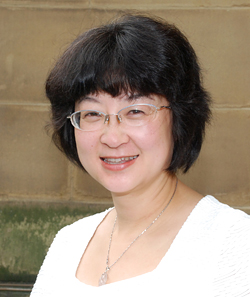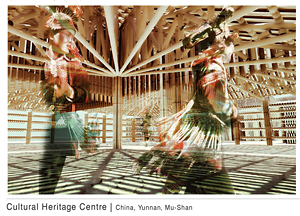Architecture students celebrated at Chinese exhibition
Fri, 06 Sep 2013 09:56:00 BST
Huddersfield extends links with Yunnan Arts University

AN exhibition of architectural designs that is expected to create massive interest in China will feature the work of a multi-national team of University of Huddersfield students.
Entitled Creative Yunnan, and including the work of 18 Huddersfield students, the exhibition has already been mounted in the city of Kunming, in collaboration with the Yunnan Arts University.
 Pictured: Amongst the representatives attending the opening of the Creative Yunnan exhibition in June were the University's Dr Yun Gao Senior Lecturer in Architecture (far left) and Professor Adrian Pitts, Head of Department for Architecture and 3D Design (centre).
Pictured: Amongst the representatives attending the opening of the Creative Yunnan exhibition in June were the University's Dr Yun Gao Senior Lecturer in Architecture (far left) and Professor Adrian Pitts, Head of Department for Architecture and 3D Design (centre).
Now it is to be repeated later this month in China when the Opening Ceremony of the exhibition takes part on the 27 September, with the full backing of the Yunnan provincial government, which will guarantee immense media interest throughout the nation.
The involvement of the students, who were in the final year of their degree in international architecture, is one of the products of a long-standing relationship between Yunnan Arts University and the University of Huddersfield. It has now led to a full Memorandum of Understanding.
As part of their course – the only one of its kind validated by the Royal Institute of British Architects (RIBA) – Architecture International BA(Hons) students at Huddersfield make at least one non-European field study trip over an extended period of 3-4 weeks.
 In late 2012, a group of 25 students – who represented eight nationalities between them – travelled to the province of Yunnan for three weeks.
In late 2012, a group of 25 students – who represented eight nationalities between them – travelled to the province of Yunnan for three weeks.
Located in south west China and with a population of 45 million, belonging to 26 ethnic groups, Yunnan offered the Huddersfield students a fascinating variety of landscapes, buildings and cultures, including ancient terraced paddy fields that have been declared a World Heritage Site.
Accompanied by Yunnan Arts University students, the visitors spent time with villagers in the ancient farming communities of Qin Kou and Mou Shang, home to the Yi people and their distinctive traditions.
Equipped with first-hand knowledge of local culture and lifestyles, the Huddersfield students returned to the UK to work on architectural projects designed to improve life in Yunnan, while preserving ethnic identities.
“It was a very stimulating region for the students, with a huge contrast between rural and urban areas and the spectacular landscapes,” said University of Huddersfield Senior Lecturer in Architecture Dr Yun Gao (pictured above), who is a native of Yunnan herself and a Visiting Professor at its Arts University.
She explained that when they came to work on their design briefs, the students tried to combine Western and Chinese ideas. “They aimed to find ways to improve local people’s lives by using some modern technologies and materials, but at the same time they tried to respect the local identity and culture,” she added.
 The projects included designs for a variety of cultural heritage and trade centres, plus village layouts and buildings. One of the students, Waqar Hussain, designed a centre specifically aimed to help with the revival of the culture of the Yi people and it earned him a Silver Medal in the 2013 RIBA Yorkshire Student Awards. (Pictured left: The Cultural Heritage Centre designed by Waqar Hussain).
The projects included designs for a variety of cultural heritage and trade centres, plus village layouts and buildings. One of the students, Waqar Hussain, designed a centre specifically aimed to help with the revival of the culture of the Yi people and it earned him a Silver Medal in the 2013 RIBA Yorkshire Student Awards. (Pictured left: The Cultural Heritage Centre designed by Waqar Hussain).
A large proportion of the Huddersfield designs were incorporated in the Creative Yunnan exhibition mounted in June, and are now to have a higher-profile repeat showing later this month in Kunming.
International architecture students at the University of Huddersfield will visit Yunnan once again in one or two years’ time. But the next global destination for members of the popular course will be a visit to Vietnam.
The lessons learned from these non-European field studies are highly varied, said Dr Gao.
“Once they look at different cultures, they actually understand more about their own cultures,” she explained. “When you have no means of comparison you take everything for granted. But once you see things differently, you think differently and you have a fresh look at your own environment.”







